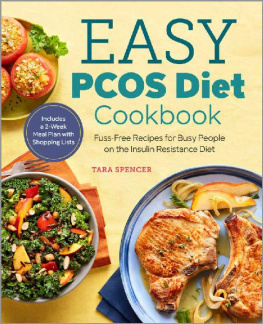Recipes for
IBS
IRRITABLE BOWEL SYNDROME

Recipes for
IBS
IRRITABLE BOWEL SYNDROME

Great Tasting Recipes and Tips Customized for Your Symptoms

Ashley Koff, R.D.
Foreword by Sonia Friedman, M.D.
Contents
CHAPTER 1
The Recipe for IBS Treatment
CHAPTER 2
The Principles:
Vegetarian and Nonvegetarian Entrees
CHAPTER 3
The Supporting Cast:
Soups, Salads, Appetizers and Sides
CHAPTER 4
The Extras:
Dips, Spreads, Sauces, and Beverages
CHAPTER 5
The Finales:
Desserts
Foreword
As long ago as 1849, W. Cumming, a physician, wrote, The bowels are at one time constipated, at another lax, in the same person. How the disease has two such different symptoms I do not profess to explain. This description of irritable bowel syndrome (IBS) is still accurate today. In fact, irritable bowel syndrome is much more prevalent than most people realize. It affects 10 to 20 percent of the adult American population and is the most common diagnosis made by gastroenterologists. The symptoms of IBS are chronic or recurrent lower abdominal pain or discomfort, altered bowel function, and bloating. Patients usually have urgency, altered stool consistency, altered stool frequency, and/or incomplete evacuation. IBS can cause great discomfort, sometimes on and off and other times continuously, for many decades in a persons life. The estimated total healthcare costs associated with IBS are about $21 billion dollars a year. The direct costs in diagnostic tests, physician and emergency room visits, hospitalizations, and medications are $1 billion. The indirect costs in reduced work productivity, absenteeism, and travel to consultations are about $20 billion.1 Of course these estimates leave out the intangible costs of human suffering and impaired quality of life.
In the United States, about two-thirds of patients who suffer from IBS are women. This may be due to the fact that women more readily report their symptoms of abdominal pain, gas, bloating, and altered bowel movements. It may also be due to hormonal differences between men and women that may affect gut function and alter perception of pain due to abdominal distention. IBS primarily affects people in the prime of their livesbetween the ages of twenty and forty. Patient surveys from both the United States and the United Kingdom report an average disease duration of eleven years with one-third of patients having symptoms for much longer.2,3 For many patients, symptoms occur frequently and significantly impair emotional, physical, and social well-being. Almost three-fourths of patients report symptoms more than once a week and about half report daily symptoms. In a telephone survey of female IBS sufferers in the United States, almost 40 percent reported pain and discomfort as intolerable without relief. Women with IBS reported 71 percent more abdominal surgeries than women without IBS. The rates of gallbladder operations, hysterectomies, and appendectomies were twice as high or higher among women with IBS. Twenty-five percent had been hospitalized overnight due to symptoms. Seventy-eight percent of women had limits on what they ate, 43 percent had limits on sports and recreational activity, 43 percent on social activity, 40 percent on vacation and travel, and 28 percent on sexual activity. Two-thirds of women were concerned about restroom availability wherever they went, one-third avoided group meetings, and 25 percent got up earlier for work.
Even more frustrating was that only 39 percent of women were diagnosed with IBS by the first physician they saw. Three percent saw eight or more physicians before getting a diagnosis. Time from onset to diagnosis took an average of three years, and patients saw an average of three physicians before getting a diagnosis.
IBS also affects productivity at work. IBS sufferers are absent an average of thirteen days per year due to symptoms, versus non-IBS sufferers who are absent an average of five days per year.4 In a recent study that compared quality of life among patients with IBS, migraine, asthma, esophageal reflux, and subjects in the general U.S. population, IBS patients had a significantly worse quality of life on all levels. IBS patients had decreased physical functioning, increased body pain, worse general health, vitality, social functioning, emotional, and mental health.5
What Exactly Is IBS?
What causes the increased gas, bloating, pain, and altered bowel movements? Historical terms describing IBS include spastic colon, irritable colon, unstable colon, nervous colon, and mucous colitis. In 1966 a physician, CJ DeLor, coined the name irritable bowel syndrome, which exists today. These historical names are interesting because they describe the endpoint of bowel pain and spasm without describing the why and how. In the 1960s and 70s, IBS was thought to be due to abnormal motility or movement of the small intestine and colon. In the 1980s and 90s it was thought to be due to an increased perception of pain to abdominal distention. To test this theory, investigators inflated a small balloon in the sigmoid colon of several IBS patients and non-IBS patients. Even with the same amount of air, IBS patients felt much more pain than non-IBS patients. Investigators then immersed the hands of IBS and non-IBS patients in ice water. The perception of pain was exactly the same. This experiment tells us that the heightened pain sensation is specific to the gut in IBS patients.6
More recently, the brains of IBS patients have been studied by a test called a functional MRI. The special MRI locates the area of the brain that is activated by distending the sigmoid colon with air. In fact, different areas in IBS patients and non-patients will light up on the MRI. This tells us that the brains of IBS and non-IBS patients respond differently to pain. In addition, there are many connections between the brain, spinal cord, and the gut. The gut will literally tell the brain how to respond when the colon is distended, and this response will be different in patients with IBS.7,8
In addition, the gut has a brain of its own. Amazingly, the gut contains 90 percent as many neurons, or nerve cells, as there are in the brain. The main chemical that controls pain sensation, gut motility, and secretion of water in the intestine is serotonin. Ninety-five percent of the nerve cells that contain serotonin are in the gut. Serotonin controls gut sensitivity and helps control consistency of stool, preventing it from becoming too hard or too soft and causing constipation or diarrhea. Serotonin is also present in the brain and is involved in modulating the brains response to pain. IBS patients may have different levels of serotonin in the gut and most likely in the brain. What this means is that IBS patients should know that their symptoms are real. They are not crazy or too stressed-out. Although stress, psychological state, coping skills, and social support can play a role in IBS, they are not the cause. What modern research will likely show is that it all comes down to altered levels of serotonin in the brain and in the gut.9,10
Even more interesting is that there is some evidence of a link between inappropriate inflammation and IBS. IBS patients may have increased inflammation in the gut on a microscopic level and increased inflammatory factors in the bloodstream. This increased inflammation may lead to an altered level of serotonin in the gut and may play a role in causing IBS.11
Next page











